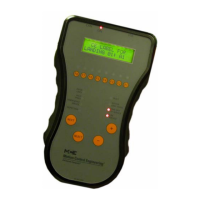Installation
2-4 Manual # 42-02-1P21
Piping and Wiring
Proper routing of signal and power wires for the car and dispatcher is essential to trouble free
installation of microprocessor based equipment. Low voltage and high voltage wiring cannot be
run in the same conduit, duct, or tray.
How Electrical Noise Occurs
Electrical noise occurs in most cases when two wires run along side one another with one of
them a high power conductor and the other a low signal level conductor. As current flows
through the high power wire, magnetic lines of flux (voltage) expand outwards around the out-
side of the wire and voltage from the magnetic lines of flux is induced in the low level conductor.
The low level conductor, in the case of Motion 2000, may be a 24-volt input that really only
needs to see 12 volts to turn on. If the voltage induced from the high power conductor is large
enough to induce a 12-volt spike, the input can falsely turn on.
How to Avoid Electrical Noise Problems
The easiest way to avoid noise problems is to properly route high and low level signal wiring.
Keep low level wiring in separate conduit from high power wiring. If high and low power wiring
must be run in the same duct, separate them by a minimum of three to four inches. If one must
cross the other, it should be at a ninety degree angle.
A second way to protect against electrical noise problems is to run low level wiring in shielded
cable. The shield provides a conductor external to the actual signal wiring to collect any induced
voltage from surrounding high power wiring. The shield or “drain”, as it is often referred to,
must be connected to ground at one end. The shield or “drain” should never be connected to
ground at both ends.
Possible EMI/RFI Interference
The main source of EMI/RFI problems is semiconductor devices that switch at high frequencies
(such as variable frequency drives). The following wiring practices should be followed when
piping and wiring high voltage lines to avoid EMI problems:
1. Run all motor leads in a separate conduit. All motor lead runs should be as short as pos-
sible. Control cabinet entry should be as close to the final termination point as possible.
2. Run main line supply leads in a separate conduit.
3. Run all primary isolation transformer wiring in separate conduit from the main line to
the transformer.
4. Run all secondary isolation transformer wiring in a separate conduit from the trans-
former to the drive cabinet.
5. A single-point ground should be established inside the control cabinet and a #8 AWG
ground wire run directly from each of the following devices to this single point:
• Earth Ground from running water supply, Motion 2000-electric supplied ground, or a
ground supplied via an earthing rod to the single ground stud.
• Continuous wire from the main line disconnect to the single ground stud.
• Continuous wire from the motor frame to the single ground stud.
• Continuous wire from the isolation transformer frame to the single ground stud.
• Continuous wire from the line filter frame to the single-point ground stud.

